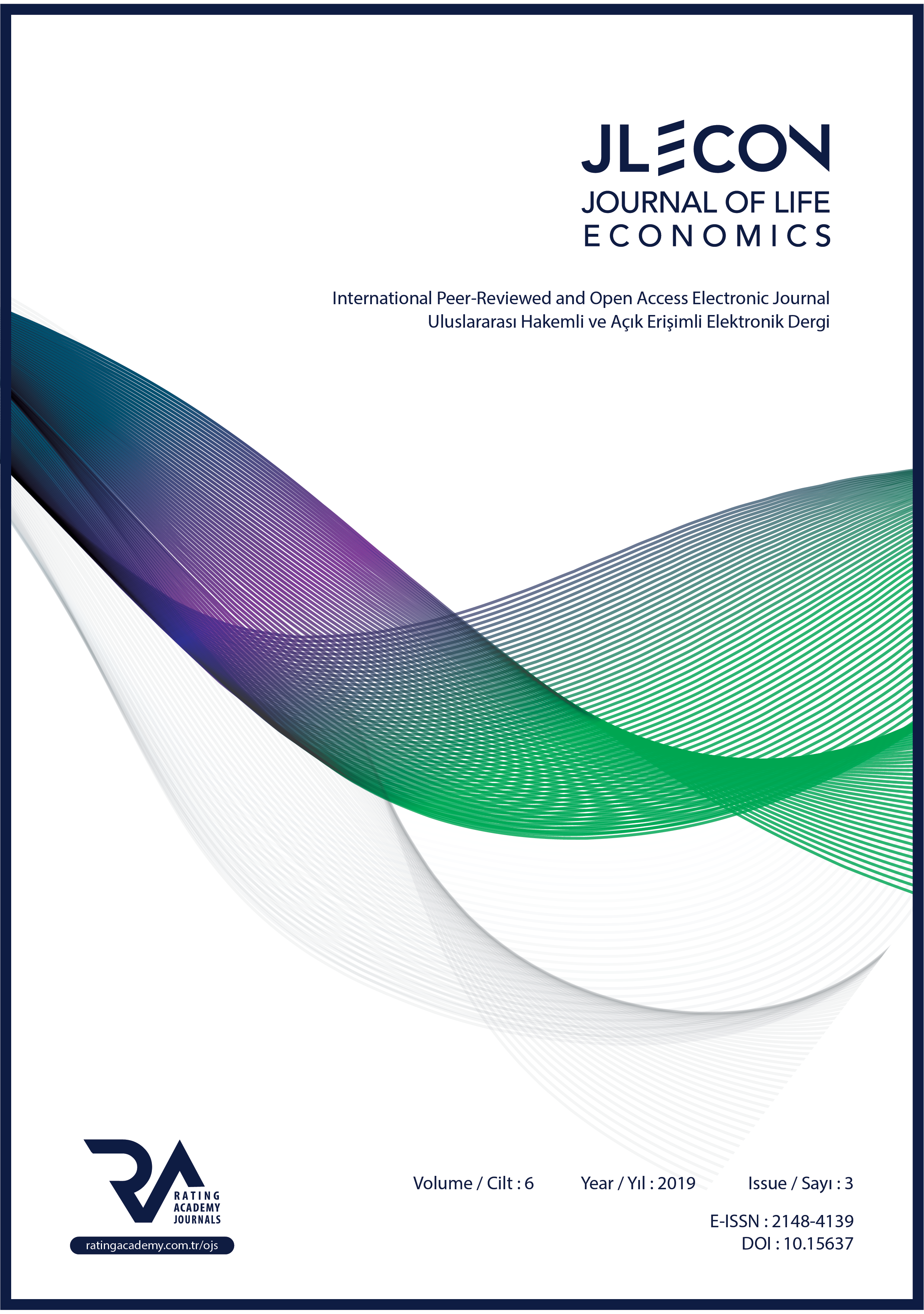ANALYSIS OF THE RELATIONSHIP BETWEEN INFLATION, BUDGET DEFICIT AND MONEY SUPPLY IN TURKEY BY ARDL APPROACH 1980-2017
DOI:
https://doi.org/10.15637/jlecon.6.018Anahtar Kelimeler:
Inflation, Deficit, Money Supply, Turkey, ARDLÖzet
Inflation is considered as a monetary phenomenon and its increase is linked with money supply according to the Monetarist view. In other words, the increase in budget deficits leads to an increase in money supply and as a result, inflation rates rise. Inflation is based on fiscal policies rather than monetary policies according to Price Level Fiscal Theory. Accordingly, increasing budget deficits leads to increases in loans, thus causes interest rates to rise and consequently inflation rises as money supply increases. In this study, the relationship between inflation, budget deficit and money supply in Turkey is analyzed using the ARDL bounds testing approach for the 1980-2017 period. According to the empirical results, there was a positive and significant relationship between inflation and budget deficit both in the long and short term.
Keywords: Inflation, Deficit, Money Supply, Turkey, ARDL
Jel Codes: E31, E51, E52
İndirmeler
Referanslar
ALTINTAŞ, H, ÇETİNKAYA, H. and TABAN, S., (2008), Türkiye’de Bütçe Açığı, Parasal Büyüme ve Enflasyon Arasındaki İlişkinin Ekonometrik Analizi: 1992–2006, Anadolu Üniversitesi Sosyal Bilimler Dergisi, 8(2), 185–208.
AKEL, V. and GAZEL, S., (2014), Döviz Kurları ile BIST Sanayi Endeksi Arasındaki Eşbütünleşme İlişkisi: Bir ARDL Sınır Testi Yaklaşımı, Erciyes Üniversitesi İktisadi ve İdari Bilimler Fakültesi Dergisi, 44, 23-41.
BAKARE, İ. A. O., ADESANYA, O.A. and BOLARINWA, S.A., (2014), Empirical Investigation Between Budget Deficit, Inflation and Money Supply in Nigeria, European Journal of Business and Social Sciences, 2(12), 120-134.
BEDİR, S. and DİKMEN, A.T., (2014), Bütçe Açığı ve Enflasyon: Türkiye İçin Bir Sınır Testi Yaklaşımı, International Conference on Eurasian Economies 2014, 1-9.
CATAO, A.V. and TERRONES, M.E., (2005), Fiscal Deficits and Inflation, Journal of Monetary Economics, 52(3), 529–554.
CHAUDHARY, M. A. S. and PARAI, A. K., (1991), Budget Deficit and Inflation: The Peruvian Experience, Applied Economics, 23(6), 1117-1121.
CHIMOBI, O.P. and IGWE, O.L., (2010), Budget Deficit, Money Supply and Inflation in Nigeria, European Journal of Economics, Finance and Administrative Sciences,19, 52-60.
DICKEY, D. and FULLER, W.A., (1981), Likelihood Ratio Statistics for Autoregressive Time Series with A Unit Root, Econometrica, 49(4), 1057-1072.
GUJARATI, D.N., (2006), Temel Ekonometri, İstanbul: Literatür Yayıncılık.
HABIBULLAH, M.S., CHEAH, C. and BAHAROM, A.H., (2011), Budget Deficits and Inflation in Thirteen Asian Developing Countries, International Journal of Business and Social Science, 2(9), 192-204.
HOANG, K. V., (2014), Budget Deficit, Money Growth and Inflation: Empirical Evidence From Vietnam, Munich Personal Repec Archive, National Graduate Institute for Policy Studies, Banking Academy, Paper No. 54488, 1-34.
HONROYIANNIS, G. and PAPAPETROU, E., (1997), Are Budget Deficits Inflationary? A Cointegration Approach, Applied Economics Letters, 4(8), 493 - 496.
KARRAS, G., (1994), Macroeconomic Effects of Budget Defecits: Further International Evidence, Journal of International Money and Finance, 13(2), 190-210.
KAYA, M.G., and ÖZ, E., (2016), Enflasyon, Bütçe Açığı ve Para Arzı İlişkisinin Türkiye Ekonomisi Açısından Değerlendirilmesi: 1980-2014 Dönemi, Manisa Celal Bayar Üniversitesi İ.İ.B.F Yönetim ve Ekonomi, 23(3), 639-651.
KESBİÇ, C., BALDEMİR, E. and BAKIMLI E., (2005), Bütçe Açıkları İle Parasal Büyüme ve Enflasyon Arasındaki İlişki: Türkiye İçin Bir Model Denemesi, Atatürk Üniversitesi İktisadi ve İdari Bilimler Dergisi, 19 (1), 81-98.
KOYUNCU, F. T., (2014), Causality Network Between Budget Deficit, Money Supply and Inflation: An Application to Turkey, International Journal of Business and Social Science, 5-10(1), 225- 235.
LEEPER, E., (1991), Equilibria Under 'Active' and 'Passive' Monetary and Fiscal Policies, Journal of Monetary Economics, 1991, 27(1), 129-147.
LOZANO, I., (2008), Budget Deficit, Money Growth and Inflation: Evidence From Colombia Case, Banco De La Republica, Borradores De Economia. No. 005127,1-25.
OKTAYER, A., (2010), Türkiye’de Bütçe Açığı, Para Arzı ve Enflasyon İlişkisi, Maliye Dergisi, Sayı: 158, 431–447.
ÖZGÜN, D. B.,(2000), An Empirical Approach to Fiscal Deficits and Inflation: Evidence From Turkey,Hazine Müstesarlıgı, Ekonomik Arastırmalar Genel Müdürlügü: Ankara.
ÖZMEN, M. and KOÇAK, F. İ., (2012), Enflasyon Bütçe Açığı ve Para Arzı İlişkisinin ARDL Yaklaşımı ile Tahmini: Türkiye Örneği, Çukurova Üniversitesi İİBF Dergisi, 6(1), 1-19.
PESARAN, H, SHIN, Y and SMITH, R.J., (2001), Bound Testing Approaches to the Analysis of Long Run Relationships, Journal of Applied Econometrics, 16(3), 289-326.
PHILLIPS, P.C.B and PERON, P., (1988), Testing for a Unit Root in Time Series Regression, Biomètrika, 75(2), 336-346.
SARGENT, T.J. and WALLACE, N. (1981), Some Unpleasant Monetarist Arithmetic, Federal Reserve Bank of Minneapolis Quarterly Review, 5(3), 1-17.
SIMS, C., (1994), A Simple Model for Study of the Determination of the Price Level and the Interaction of Monetary and Fiscal Policy, Economic Theory, 4(3), 381-399.
ŞAHİN, İ. and KARANFİL, M., (2015), Türkiye Ekonomisinde 1980-2013 Dönemi Para Arzının Enflasyon Üzerindeki Etkisi, Business and Economics Research Journal, 6(4), 97-113.
TEKIN, K. A. and ÖZMEN, E., (2003), Budget Deficits, Money Growth and Inflation: The Turkish Evidence, Applied Economics, 35(5), 591-596.
UYGUR, E., (2001), Enflasyon, Para ve Mali Baskı: İktisat Politikasında Geri Kalmışlık, İktisat İsletme ve Finans, 16(189), 7-23.
WOODFORD, M., (2001), Fiscal Requirements for Price Stability, Journal of Money, Credit and Banking, 33(3), 669-728.
İndir
Yayınlanmış
Nasıl Atıf Yapılır
Sayı
Bölüm
Lisans
Telif Hakkı (c) 2019 Jolistence Publications

Bu çalışma Creative Commons Attribution 4.0 International License ile lisanslanmıştır.
Yazarlar, makale Journal of Economics'te yayınlanmak üzere kabul edildiğinde .makalenin içeriğindeki tüm telif haklarını, Holistence Publications'a devrederler. Yazarlar, patent hakları gibi telif hakkı dışındaki tüm mülkiyet haklarını saklı tutar.
Bu makalede yazar olarak listelenen herkes çalışmaya önemli, doğrudan, entelektüel katkılar yapmış olmalı ve bunun için kamu sorumluluğu almalıdır.
Bu makale daha once yayınlanmamış ve başka dergilerde yayınlanmak üzere gönderilmemiştir.













